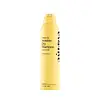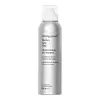Eva NYC Freshen Up Invisible Dry Shampoo Versus Living Proof Perfect Hair Day Advanced Clean Dry Shampoo
What's inside
What's inside
 Key Ingredients
Key Ingredients

No key ingredients
 Benefits
Benefits

 Concerns
Concerns

 Ingredients Side-by-side
Ingredients Side-by-side

Isobutane
Propane
Alcohol Denat.
AntimicrobialOryza Sativa Starch
AbsorbentCyclodextrin
AbsorbentZea Mays Starch
AbsorbentFurcellaria Lumbricalis Extract
Skin ConditioningHydrated Silica
AbrasiveHydroxypropyl Arginine Lauryl/Myristyl Ether Hcl
Skin ConditioningTetraselmis Suecica Extract
Skin ConditioningIsopropyl Lauroyl Sarcosinate
Skin ConditioningCetrimonium Chloride
AntimicrobialGlycerin
HumectantMannitol
HumectantPolyvinyl Alcohol
Disteardimonium Hectorite
StabilisingWater
Skin ConditioningParfum
MaskingCitronellyl Methylcrotonate
MaskingLinalool
PerfumingCitronellol
PerfumingBenzyl Salicylate
PerfumingCitral
PerfumingLimonene
PerfumingIsobutane, Propane, Alcohol Denat., Oryza Sativa Starch, Cyclodextrin, Zea Mays Starch, Furcellaria Lumbricalis Extract, Hydrated Silica, Hydroxypropyl Arginine Lauryl/Myristyl Ether Hcl, Tetraselmis Suecica Extract, Isopropyl Lauroyl Sarcosinate, Cetrimonium Chloride, Glycerin, Mannitol, Polyvinyl Alcohol, Disteardimonium Hectorite, Water, Parfum, Citronellyl Methylcrotonate, Linalool, Citronellol, Benzyl Salicylate, Citral, Limonene
 Reviews
Reviews

Ingredients Explained
These ingredients are found in both products.
Ingredients higher up in an ingredient list are typically present in a larger amount.
Alcohol Denat. is an alcohol with a denaturant property. It is created by mixing ethanol with other additives.
This ingredient gets a bad rep because it is irritating and drying - mostly due to its astringent property. Astringents draw out natural oils in tissue, constricting pores and leaving your skin dried out.
However, alcohol denat. is not all that bad.
Due to its low molecular weight, alcohol denat. tends to evaporate quickly. One study on pig skin found half of applied alcohol evaporated in 10 seconds and less than 3% stayed on skin.
This also helps other ingredients become better absorbed upon application.
Studies are conflicted about whether this ingredient causes skin dehydration. One study from 2005 found adding emollients to propanol-based sanitizer decreased skin dryness and irritation. Another study found irritation only occurs if your skin is already damaged.
Small amounts of alcohol are generally tolerated by oily skin or people who live in humid environments.
The rule of thumb is if this alcohol is near the end of an ingredients list, it will probably not affect your skin much.
Also...
This ingredient has antimicrobial and solvent properties.
The antimicrobial property helps preserve products and increase their shelf life. As a solvent, it helps dissolve other ingredients.
Other types of astringent alcohols include:
Learn more about Alcohol Denat.Disteardimonium Hectorite comes from the clay mineral named hectorite. It is used to add thickness to a product.
It can also help stabilize a product by helping to disperse other ingredients.
Hectorite is a rare, white clay mineral.
Learn more about Disteardimonium HectoriteOryza Sativa Starch is an absorbent and used to mattify the skin. It is a natural carbohydrate and the main component of rice. A more common name for this ingredient is 'rice starch'.
Rice starch is created by steeping broken grains in a caustic soda.
Rice extract has many skin benefits. Read more about rice extract here.
Learn more about Oryza Sativa StarchParfum is a catch-all term for an ingredient or more that is used to give a scent to products.
Also called "fragrance", this ingredient can be a blend of hundreds of chemicals or plant oils. This means every product with "fragrance" or "parfum" in the ingredients list is a different mixture.
For instance, Habanolide is a proprietary trade name for a specific aroma chemical. When used as a fragrance ingredient in cosmetics, most aroma chemicals fall under the broad labeling category of “FRAGRANCE” or “PARFUM” according to EU and US regulations.
The term 'parfum' or 'fragrance' is not regulated in many countries. In many cases, it is up to the brand to define this term.
For instance, many brands choose to label themselves as "fragrance-free" because they are not using synthetic fragrances. However, their products may still contain ingredients such as essential oils that are considered a fragrance by INCI standards.
One example is Calendula flower extract. Calendula is an essential oil that still imparts a scent or 'fragrance'.
Depending on the blend, the ingredients in the mixture can cause allergies and sensitivities on the skin. Some ingredients that are known EU allergens include linalool and citronellol.
Parfum can also be used to mask or cover an unpleasant scent.
The bottom line is: not all fragrances/parfum/ingredients are created equally. If you are worried about fragrances, we recommend taking a closer look at an ingredient. And of course, we always recommend speaking with a professional.
Learn more about Parfum